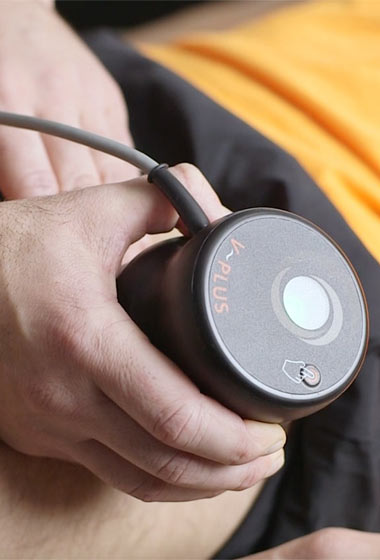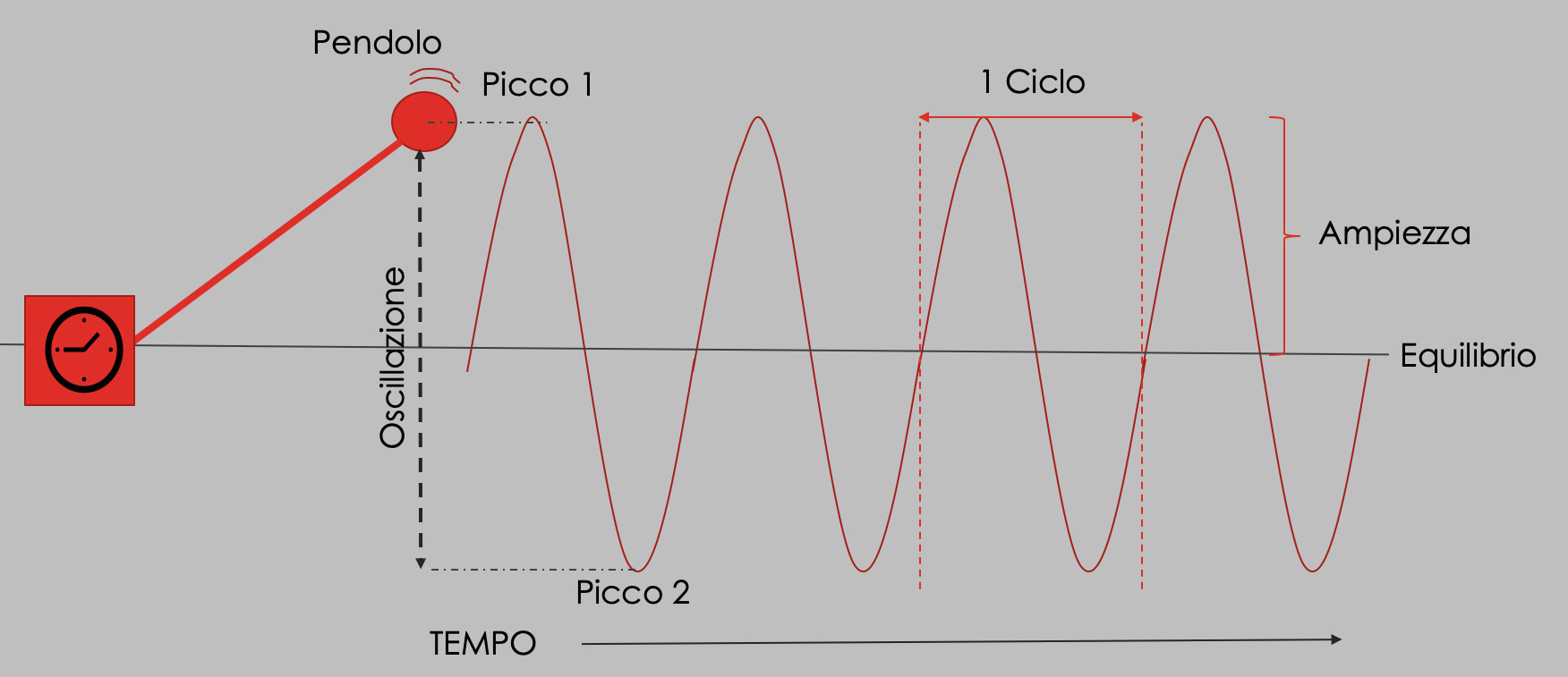Focal vibration
A walk, a car trip, a pat on the back, a handshake… in daily life we are continually subject to different types of stimuli, many of which are generated by mechanical vibratory phenomena. The impact of footsteps on the ground, the car wheels rolling perceived through the seat or shockwaves propagating through the body after an impact, produce vibrations that the organism perceives and analyzes generating a feedback.
But what is a vibration? We can describe it as an oscillatory movement centered on a point of balance; the movement of a pendulum represents a good example of oscillation. The environment around us is full of vibrations: sound, for example, is actually a vibration transmitted through air. Our body is literally covered with mechanisms capable of perceiving many types of vibrations although we are far from perceiving them all.
To understand what types of vibrations affect the human body, we can begin by defining the basic variables that describe a vibration: frequency and amplitude.
Frequency measures the amount of oscillations that occur per second, i.e. the amount of cycles in a unit of time.
In the case of the pendulum, the oscillatory motion occurs once per second, i.e. at the frequency of 1 Hertz (Hz). If by some remote chance the pendulum mechanism could accelerate completing 2 oscillations per second we could speak about 2 Hz, and so on. The range of sounds generally perceived by the human ear ranges from 20 to 20,000 Hz. Thus, when a sound is heard, the ear sends a signal to the central nervous system with different characteristics depending on the type of vibration it receives: for example, the sound of a drum resonating at 40 Hz is not the same we perceive when hearing a whistle resonating at over 10,000 Hz.
The second variable, that is to say the amplitude, measures the distance traveled by a point identified within the vibrating element, from its equilibrium position to the position where it will reverse its motion and begin to approach the equilibrium position once again.
In the case of the aforementioned pendulum, it would be nothing else but the distance traveled from its equilibrium position to the position where the pendulum starts to reverse its direction.
In the case of sound waves, the wider they are the more intense the sound will be; as their amplitude decreases it will be increasingly difficult for the ear to perceive them.
In addition to sounds, there are other types of vibrations that can stimulate the body; in the body we have in fact different types of mechano-receptors, distributed in different parts of the body, that capture these signals and classify them in various ways: one of these is based on their anatomical composition and their mechanical-electrical behavior.
As with switches, depending on the type of components and their arrangement, the receptors can be operated by different stimuli.
Based on this classification, different types of mechanoreceptors are susceptible to different types of mechanical stimuli. The precise role of each type of mechano-receptor is still a topic of discussion and further in-depth study in the scientific community.
However, numerous studies published in over half a century allow us to assert that different mechano-receptors behave relatively selectively depending on the type of mechanical / vibratory stimulus investing them whereas the functional system to which they belong identifies the sensory path of the afferent signals consequently triggered by the stimulus, conditioning as a result the response feedback.

For example, the Pacinian corpuscles are receptors sensitive to higher vibratory frequencies than other mechano-receptors and are defined as “rapid adapting”; they are able to bring their action potential to rest in a few milliseconds.
In the 1960s literature, authors such as Loewenstein and Skalak, observed and described the mechanical model of these corpuscles, while in the following decade, authors like Ferrington, Nail or Rowe, analyzed and described the influence that these corpuscles may have on sensory perception depending on the different types of mechanical stimulus, highlighting a particular sensitivity of these corpuscles at frequencies between 40 Hz and 1000 Hz; identifying the most efficient frequency to stimulate them around 300 Hz. In the 1990s a systematic review regarding this type of corpuscle was published; among the various topics, it was highlighted how, from an anatomical point of view, these corpuscles are located in different parts of the body including tendons, muscle bands and internal organs although the highest concentration is to be found both in the deep dermis of the hands, particularly in the fingertips.
Other types of corpuscles are for example Meissner corpuscles, also rapid adapting and particularly sensitive to movement, or Merkel discs, defined as slow adapting, more sensitive to the stimulus of pressure; finally Ruffini endings that, in addition to having a role in detecting temperature and being also slow adapting, are sensitive to “stretching”, localized in the deep dermis and in the joints and are able to detect the tension state of tissues providing essential information to the CNS, thus allowing to adapt the movement.
Tactile perception and proprioceptive adaptation are a result of the synthesis of the information that these receptors send to the central nervous system which, in addition to analyzing this information, sends efferent trains of impulses to the peripheral nervous system to trigger adaptation.
The clinical role of these receptors is widely discussed in literature and much more needs to be discovered. They can be analyzed as a predictive element of a pathology, for example when they present themselves with an anomalous morphology or react abnormally to stimuli or, conversely, they can also be used as a communication channel useful to trigger an informative stimulus capable of generating an adaptive response on the central nervous system.
The effects of vibration on the human body have been studied and published for over a century. The most recent studies have investigated how the vibratory stimulus is capable of generating positive effects on the body.
The effects of vibration on the human body have been studied and published for over a century. The most recent studies have investigated how the vibratory stimulus is capable of generating positive effects on the body.
In the therapeutic field it is possible to distinguish vibration using two main discriminants: frequency and the portion of body to which it is applied.
Based on the frequency, it is possible to identify high frequency stimuli, i.e. from 70 Hz upwards, and low frequency stimuli, i.e. up to 70 Hz.
Based on the portion of the body treated, literature describes:
- Whole body vibration, when the stimulus affects the whole body starting mainly from the lower limbs where they are used as a sounding board to transmit the stimulus to the rest of the body;
- Focal vibration, when the stimulus affects a well-identified portion of the body through special transducers. If the concept of protocol is also added to the concept of focal vibration, we can then speak of “repeated focal vibration”.
The fundamental difference between focal and whole body vibration lies in two interconnected elements: resonance and diffusion of the stimulus.

As for the first element, by causing a vibration to the body using a vibratory stimulus applied to the limbs, due to the mechanical characteristics of the tissues, which have different rigidity, the resonance of the vibration that pervades the body when applying the whole body vibration generates a vibration which resonates at different frequencies on the different types of tissue according to their rigidity, thus making it difficult to provide a selective and controlled stimulus.
As for the second element, the amplitude of the vibration necessary to exercise a stimulus that pervades a large part of the body, often presents contraindications that limit the use of this type of stimulus.
In the case of focal vibration, it is possible to control both frequency and amplitude precisely in the points where the vibratory stimulus is indicated, reducing contraindications to a minimum and allowing better selectivity.

The application fields are wide and new studies that describe the use of vibration in new branches of medicine are published every year.
To date, the therapy has given promising results in several fields: post stroke course, post-surgical rehabilitation, osteoporosis, damage to the peripheral nervous system, muscle atrophy, orthopedic rehabilitation, geriatrics, sports performance.
The reasons adduced and studied that allow to reach the therapeutic result are generally attributed to two macro categories of induced reactions:
- modification of some hormonal parameters following the stimulus, as for some growth factors and for cortisol;
- modification of the plasticity of the central nervous system which occurs with different modulations depending on whether healthy people or patients with temporary motor disabilities are treated.
If you are interested in going deeper into the topic, if you would like to receive more information about our products or would like to deepen the bibliography regarding focal vibration, please contact us.






